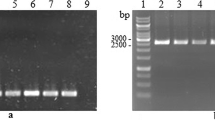Abstract
An Aspergillus nidulans strain, auxotrophic for pyrimidine, was transformed to prototrophy by means of microprojectile bombardment. The transformation frequency was somewhat lower than conventional polyethyleneglycol-mediated transformation of protoplasts. However, the percentage of stable transformants was considerably higher with the biolistic approach. Typically, integrations of several copies of the plasmid introduced into chromosomal DNA were observed. The effect of several parameters, like the concentration of conidia, chamber pressure during bombardment and size of microprojectiles, on transformation frequencies were investigated and compared to previously published data on microprojectile bombardment of fungal conidia. Optimum results (6 transformants/μg plasmid DNA) were obtained when 108 conidia were bombarded with a helium pressure of 5.5–8.3 MPa (800–1200 lb/in2). M5, M10 and M17 tungsten particles were equally efficient.
Similar content being viewed by others
Author information
Authors and Affiliations
Additional information
Received: 9 August 1995/Received revision: 27 September 1995/Accepted: 4 October 1995
Rights and permissions
About this article
Cite this article
Herzog, R., Daniell, H., Singh, N. et al. A comparative study on the transformation of Aspergillus nidulans by microprojectile bombardment of conidia and a more conventional procedure using protoplasts treated with polyethyleneglycol. Appl Microbiol Biotechnol 45, 333–337 (1996). https://doi.org/10.1007/s002530050692
Issue Date:
DOI: https://doi.org/10.1007/s002530050692




